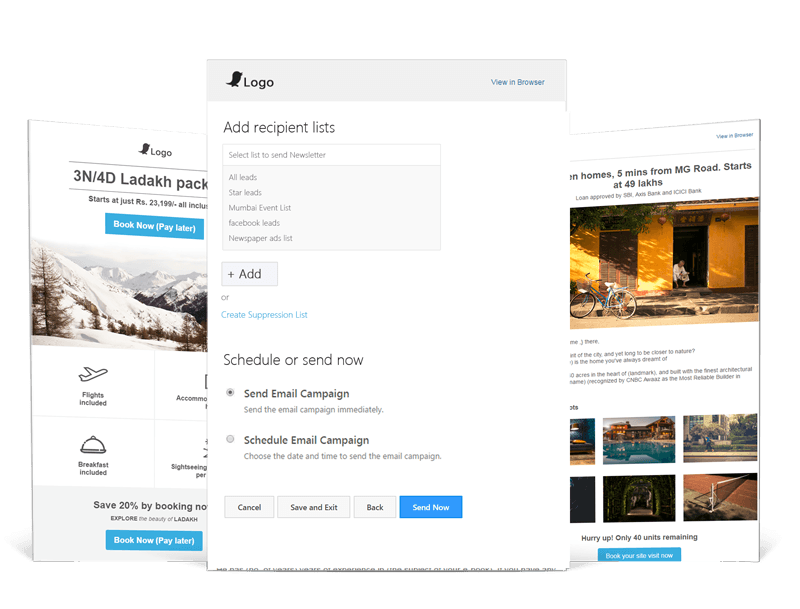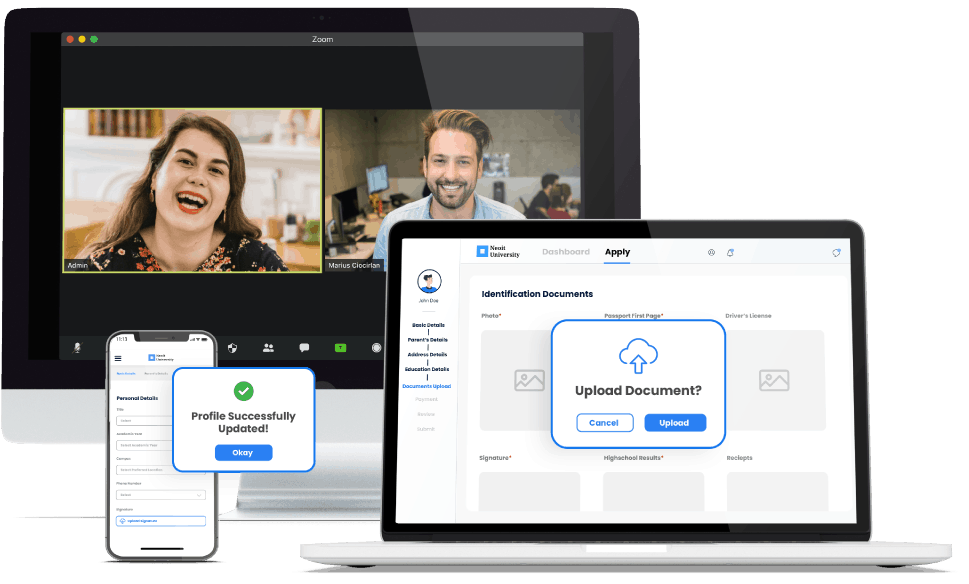The pandemic has left its mark on the traditional sales process. Today, reps are expected to work in a more virtual environment. According to Gartner:
- 74% of CSOs (Chief Sales Officers) have recently updated or are updating their seller skills profile to include virtual selling
- 41% of them have created new hybrid field/virtual roles, and
- 37% of them have permanently transitioned some or all field sales to virtual roles
Remote or virtual selling will become the new normal even when the effects of the pandemic subside. Amidst this, what are the desirable skills, what new strategies do sales-led organizations from across the globe follow, and how to ace online sales – we’ll cover all these points in this article.
Contents:
>> Virtual prospecting
>> Virtual customer engagement
>> Digital customer onboarding
>> Competencies for virtual selling
Ace virtual sales!
Virtual selling is managing and executing sales online – from prospecting to customer engagement and onboarding.
Let’s look at all aspects of the virtual sales process one by one.
Virtual prospecting
Prospecting is essential to create a sales pipeline. Without it, no one can imagine sales. When the pandemic struck, prospecting suffered the most. While it was easy to find buyers online, setting up a cadence remained a challenge.
Nonetheless, several tools and strategies evolved to prospect in a virtual world.
For instance, a new trend we see is social selling. Social selling refers to using your and your company’s social media channels to connect with prospects and develop a connection with them. In short, social selling is:
- Leveraging social networks
- A team effort. Everyone must comment, post updates, and engage with the audience
- Giving prospects insights into who you are.
Note that social selling is not only about the marketing team posting on social media. It involves everyone from sales reps to directors and executives participating – liking, sharing, and commenting on your posts. People want to know about the company, its people, and social media is the best way to engage with prospects online.
Comments are the new posts. And if you want to be on the top of their mind, you better be on the top of their feed.
Kim Orlesky, CEO @ KO Advantage Group
Do not hesitate to DM (Direct Message) your prospects. Do not think that DMs are informal. You can use social channels and still be professional.
Apart from social selling strategy, you can use the following evergreen techniques for virtual prospecting.
- Create online events and webinars
- Attend virtual conferences
- Participate in communities
Now, there are two types of communities that may be relevant to you. One is the sales community, where you hang out with your peers. Another is the community where your prospects hang out. Join those communities and engage in discussions there.
You can also use sales prospecting tools to find leads and engage with them through emails or cold outreach campaigns.
Examples of popular sales prospecting tools:
- LinkedIn Sales Navigator
- ZoomInfo
- Clearbit Prospector
- Prospect.io
- Milkshake
All these tools will help you find contact information and other details of business leads. You can also integrate prospecting tools with CRM to track the lead journey and conversions.

Virtual customer engagement
Earlier, the sales meetings would span more than an hour. But in a virtual setting, the average meeting duration is reduced to 20-30 minutes. It means that you’ll have to get to the point immediately – without too many formalities.
If your first one or two meetings are valuable, even though they might be brief, they’ll open doors for more comprehensive future interactions. But make sure you start and end on time. People might not wait for you beyond 5 minutes, and neither they’ll appreciate it if the meeting drags too long. In short:
Be bold and be brief.
Tips for better virtual meetings:
- Limit the number of people on the call
- Test lightings and mike and avoid distractions/background noise
- Keep your webcam on and focus on the camera (You’re 127% more likely to close a business when your webcam is on.)
- Call on specific names during the conversation
- Prepare agenda and possible questions
Limit your first meeting to only 20 minutes, 45 minutes to the second meeting, and 30-60 minutes to subsequent meetings.
Experts suggest that 20 minutes meetings over weeks will engage prospects better than marathon meetings within a week.
Note that not all meetings will lead to conversion. Sometimes there could be a fitment gap, or at other times, the buyer would not be ready to buy yet.
Therefore, have a customer engagement plan in place. Engage with them through relevant events and content.
Tools for customer engagement:
- CRM: LeadSquared, Salesforce, HubSpot
- Virtual events software: Livestorm, GoToWebinar
- Email marketing automation: LeadSquared CRM, MailChimp, Sendfox

Make sure you track every interaction with your prospect across channels. Also, use a tool to automatically move them in the sales pipeline based on the activities that indicate buying intent.
If you’re planning to engage with buyers through email campaigns, here’s some advice.
- Follow a structured approach while writing cold emails. It should contain the problem statement, solution, and a call-to-action – in that order.
- Wrap up your message in 75-100 words (Think how many times your prospect will scroll, especially on the phone)
- Ask for their opinion. Don’t make your emails a one-way communication, where you only keep sending emails without getting any response from the prospect.
Customer onboarding
Customer onboarding is the process of getting new users acquainted with your product. The way you onboard customers will determine your relationship with them. Onboarding also has a direct impact on CLV (customer lifetime value) as happy customers stay.
Many people think the sales process ends once the customer signs the document. But that’s not true. Even though companies might have a separate customer success team, salespeople play an important role in making the customer comfortable with the product. After all, it’s the sales rep whom the customer trusted and bought the product.
Another trend that’s swamping the digital world is automated customer onboarding, where customers onboard themselves through self-serve portals.
However, not all customers are familiar with the virtual onboarding process. Therefore you must walk them through the steps to ensure smooth onboarding.
Here are some helpful tips:
- Set the right expectations. That is, show them where they’re in the process and how much more time it will take to complete the process and get them started.
- Break things down. Instead of explaining the requirements all at once, make onboarding simpler by breaking it into steps. It will reduce the cognitive load on the user.
- Highlight the new and essential features. Don’t assume users will know everything on their own. Neither do believe that they’ll recall everything from your sales call.
- Let them discover your product. Instead of spoon-feeding every piece of information, let the user engage with your offering by exploring things themselves. It will keep their interest in your product alive.
- Prepare video tutorials. Cover the difficult aspects of your product through how-to videos.
- Keep in touch. As a person who introduced them to your company, regularly ask for their wellbeing, feedback, and if you can help them further.
Make sure you update your marketing list and remove the customers from your nurturing campaigns. Create a separate emailing list for customers to send regular product and feature release updates.
Tools that help in customer onboarding are:
- Self-serve portals: LeadSquared
- Onboarding software: Whatfix, CustomerSuccessBox, Loom, Gainsight PX
- Digital signature tools: DocuSign, PandaDoc, Adobe Sign
- eKYC/Video KYC: LeadSquared, Kwik.ID, Signzy

Competencies for virtual selling
Earlier, tech-supported tasks were considered optional or good-to-have skills. Now, it has become a necessity. Not only this, but technology is also helping salespeople be more productive, make smart decisions, and sell faster.
However, virtual selling is hard. It takes more discipline, not less.
At the core, you’ll need to have:
- Ability and ambition to work digitally
- Understanding of data and digital tools
- Ability to coordinate with internal teams, external vendors, and customers
We can take you a step further in your virtual selling process. We have enabled start-ups and leaders to execute high-velocity sales in a virtual environment. Book a quick demo and see how we can transform your business.
Sources: salessecretssummit.com, Gartner










